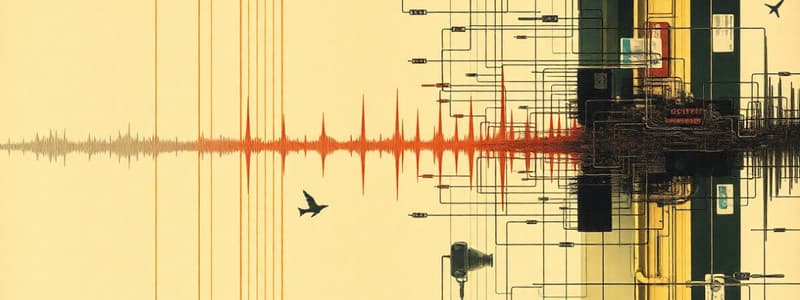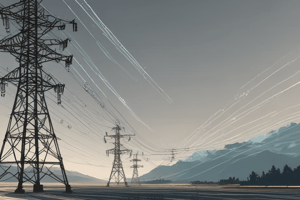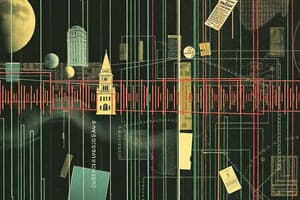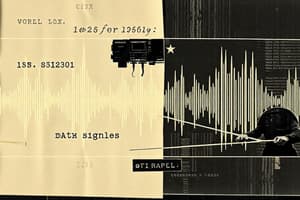Podcast
Questions and Answers
What is the relationship between the required bandwidth and bit rate in baseband transmission?
What is the relationship between the required bandwidth and bit rate in baseband transmission?
- Required bandwidth is proportional to bit rate. (correct)
- Required bandwidth is independent of bit rate.
- Required bandwidth decreases as bit rate increases.
- Required bandwidth is inversely proportional to bit rate.
What type of signal is primarily used in broadband transmission?
What type of signal is primarily used in broadband transmission?
- Digital signals
- Binary signals
- Analog signals (correct)
- Discrete signals
Which of the following is a characteristic of unidirectional broadband communication?
Which of the following is a characteristic of unidirectional broadband communication?
- Utilizes only digital transmission methods.
- Requires one pathway for both sending and receiving.
- Requires two pathways for sending and receiving. (correct)
- Can send and receive simultaneously on the same channel.
Which of the following is NOT a cause of transmission signal impairment?
Which of the following is NOT a cause of transmission signal impairment?
What does attenuation refer to in signal transmission?
What does attenuation refer to in signal transmission?
What measurement is used to express the relative strengths of signals in transmission?
What measurement is used to express the relative strengths of signals in transmission?
What is a common outcome of signal distortion?
What is a common outcome of signal distortion?
What does a high Signal-to-Noise Ratio (SNR) indicate about the signal?
What does a high Signal-to-Noise Ratio (SNR) indicate about the signal?
Which factor does NOT contribute to noise in signal transmission?
Which factor does NOT contribute to noise in signal transmission?
Which formula represents the Shannon capacity for a noisy channel?
Which formula represents the Shannon capacity for a noisy channel?
How can increasing the number of signal levels impact the data transmission?
How can increasing the number of signal levels impact the data transmission?
What is the relationship between bandwidth in hertz and bandwidth in bits per second?
What is the relationship between bandwidth in hertz and bandwidth in bits per second?
Which type of noise primarily corrupts signals by causing unwanted interference?
Which type of noise primarily corrupts signals by causing unwanted interference?
What does the term 'Nyquist bit rate' refer to?
What does the term 'Nyquist bit rate' refer to?
What equation correctly defines the Signal-to-Noise Ratio in decibels (SNRdB)?
What equation correctly defines the Signal-to-Noise Ratio in decibels (SNRdB)?
Which factors affect the data rate in data communications?
Which factors affect the data rate in data communications?
What is the main difference between analog and digital data?
What is the main difference between analog and digital data?
How are the bandwidth and frequency of a composite periodic analog signal defined?
How are the bandwidth and frequency of a composite periodic analog signal defined?
What is a characteristic of baseband transmission?
What is a characteristic of baseband transmission?
What does baud rate specifically refer to?
What does baud rate specifically refer to?
In a digital signal with L levels, how do you determine the number of bits per level?
In a digital signal with L levels, how do you determine the number of bits per level?
Which of the following statements about baseband transmission is correct?
Which of the following statements about baseband transmission is correct?
Which of the following correctly describes the relationship between bit rate and baud rate?
Which of the following correctly describes the relationship between bit rate and baud rate?
What classifies a signal as a composite periodic analog signal?
What classifies a signal as a composite periodic analog signal?
What is the purpose of throughput in network transmission?
What is the purpose of throughput in network transmission?
Which of the following is not a type of data (or) signal encoding?
Which of the following is not a type of data (or) signal encoding?
What does baseband communication imply about signal directionality?
What does baseband communication imply about signal directionality?
If a digital signal has eight levels, how many bits are required per level?
If a digital signal has eight levels, how many bits are required per level?
What does the variable 'r' represent in the relationship S = N x 1 / r?
What does the variable 'r' represent in the relationship S = N x 1 / r?
Which device utilizes digital-to-analog conversion to connect a digital source to analog media?
Which device utilizes digital-to-analog conversion to connect a digital source to analog media?
In data transmission, how does increasing the data rate generally affect the signal rate?
In data transmission, how does increasing the data rate generally affect the signal rate?
Which aspect distinguishes throughput from bandwidth?
Which aspect distinguishes throughput from bandwidth?
What is the bandwidth range of twisted pair cables?
What is the bandwidth range of twisted pair cables?
Which of the following statements correctly describes the use of coaxial cables?
Which of the following statements correctly describes the use of coaxial cables?
What is a primary advantage of optical fiber cables over twisted pair cables?
What is a primary advantage of optical fiber cables over twisted pair cables?
What type of twisted pair cable is predominantly used in outdoor areas?
What type of twisted pair cable is predominantly used in outdoor areas?
How do stranded twisted pair cables differ from solid twisted pair cables?
How do stranded twisted pair cables differ from solid twisted pair cables?
Which of the following cable types offers the largest bandwidth?
Which of the following cable types offers the largest bandwidth?
What is the primary reason for modulating an analog signal?
What is the primary reason for modulating an analog signal?
What is the main component used in fiber-optic cables for data transmission?
What is the main component used in fiber-optic cables for data transmission?
Which technique is commonly used for converting analog to digital signals?
Which technique is commonly used for converting analog to digital signals?
Which of the following cables is generally not used for data communications?
Which of the following cables is generally not used for data communications?
What is necessary for digital-to-digital conversion?
What is necessary for digital-to-digital conversion?
Which of the following is NOT a type of un-guided transmission media?
Which of the following is NOT a type of un-guided transmission media?
Which transmission medium is used for Wireless LANs?
Which transmission medium is used for Wireless LANs?
In guided transmission media, which of these options is NOT included?
In guided transmission media, which of these options is NOT included?
What are the three techniques involved in digital-to-digital conversion?
What are the three techniques involved in digital-to-digital conversion?
Which of these transmission media is considered un-guided?
Which of these transmission media is considered un-guided?
What is required to compensate for signal energy loss due to attenuation during transmission?
What is required to compensate for signal energy loss due to attenuation during transmission?
Which of the following accurately describes the consequence of distortion in a transmitted signal?
Which of the following accurately describes the consequence of distortion in a transmitted signal?
How does broadband transmission enable simultaneous data transmissions?
How does broadband transmission enable simultaneous data transmissions?
Which factor does NOT contribute to transmission signal impairment?
Which factor does NOT contribute to transmission signal impairment?
What does noise in signal transmission primarily refer to?
What does noise in signal transmission primarily refer to?
Which statement is true regarding frequency-division multiplexing in broadband transmission?
Which statement is true regarding frequency-division multiplexing in broadband transmission?
What happens when a signal experiences attenuation in transmission?
What happens when a signal experiences attenuation in transmission?
In what scenario would phase difference at the receiver most likely occur?
In what scenario would phase difference at the receiver most likely occur?
What does a low Signal-to-Noise Ratio (SNR) imply about the data transmission?
What does a low Signal-to-Noise Ratio (SNR) imply about the data transmission?
In the context of data communications, how does increasing bandwidth in hertz affect data rate?
In the context of data communications, how does increasing bandwidth in hertz affect data rate?
Which formula would you use to calculate the theoretical maximum bit rate of a channel with noise?
Which formula would you use to calculate the theoretical maximum bit rate of a channel with noise?
What challenges might arise from increasing the number of signal levels used to represent data?
What challenges might arise from increasing the number of signal levels used to represent data?
Which term describes the measurement of signal strength relative to noise in a transmission?
Which term describes the measurement of signal strength relative to noise in a transmission?
Which unit is used to express the Signal-to-Noise Ratio (SNR) in terms of its decibel value?
Which unit is used to express the Signal-to-Noise Ratio (SNR) in terms of its decibel value?
Which of the following does not directly affect the data rate of a communication channel?
Which of the following does not directly affect the data rate of a communication channel?
What does the Nyquist bit rate calculate for a noiseless channel?
What does the Nyquist bit rate calculate for a noiseless channel?
What is the main reason for using analog-to-analog conversion techniques?
What is the main reason for using analog-to-analog conversion techniques?
How does throughput differ from bandwidth in data communications?
How does throughput differ from bandwidth in data communications?
What technique is predominantly used for converting analog signals into digital data?
What technique is predominantly used for converting analog signals into digital data?
What is the maximum bandwidth of twisted pair cables?
What is the maximum bandwidth of twisted pair cables?
Which of the following describes Guided Transmission Media?
Which of the following describes Guided Transmission Media?
In the formula $S = N x 1 / r$, what does the variable 'N' represent?
In the formula $S = N x 1 / r$, what does the variable 'N' represent?
Which type of coaxial cable is described as inflexible and requires special equipment for connection?
Which type of coaxial cable is described as inflexible and requires special equipment for connection?
Which of the following types of waves is NOT typically associated with un-guided transmission media?
Which of the following types of waves is NOT typically associated with un-guided transmission media?
What characteristic is true for a digital-to-analog conversion process?
What characteristic is true for a digital-to-analog conversion process?
Which statement is true regarding optical fiber cables?
Which statement is true regarding optical fiber cables?
What is the primary factor that affects the relationship between baud rate and bit rate?
What is the primary factor that affects the relationship between baud rate and bit rate?
Which of the following techniques for Digital-to-Digital conversion may not always be necessary?
Which of the following techniques for Digital-to-Digital conversion may not always be necessary?
Which statement accurately describes the characteristics of analog data?
Which statement accurately describes the characteristics of analog data?
In terms of data transmission, what is a key limitation of baseband communication?
In terms of data transmission, what is a key limitation of baseband communication?
Which of the following statements is true regarding un-guided transmission media?
Which of the following statements is true regarding un-guided transmission media?
Which of the following conversions allows digital data to be sent over long-distance communication links?
Which of the following conversions allows digital data to be sent over long-distance communication links?
What distinguishes Unshielded Twisted Pair (UTP) from Shielded Twisted Pair (STP)?
What distinguishes Unshielded Twisted Pair (UTP) from Shielded Twisted Pair (STP)?
What is a characteristic of line coding in digital signal transmission?
What is a characteristic of line coding in digital signal transmission?
What does the term 'r = log_2 L' signify in data transmission?
What does the term 'r = log_2 L' signify in data transmission?
What is one advantage of stranded twisted pair cables over solid twisted pair cables?
What is one advantage of stranded twisted pair cables over solid twisted pair cables?
How is the bandwidth of a composite analog signal defined?
How is the bandwidth of a composite analog signal defined?
What differentiates baud rate from bit rate in analog transmission of digital data?
What differentiates baud rate from bit rate in analog transmission of digital data?
Why are coaxial cables becoming less popular in data communications?
Why are coaxial cables becoming less popular in data communications?
In the context of transmission media, which of the following best defines 'guided media'?
In the context of transmission media, which of the following best defines 'guided media'?
When considering digital signals, what does the term 'L levels' refer to?
When considering digital signals, what does the term 'L levels' refer to?
Which of the following best describes the nature of digital signals?
Which of the following best describes the nature of digital signals?
What is a unique characteristic of fiber-optic cables compared to other guided media?
What is a unique characteristic of fiber-optic cables compared to other guided media?
Which of the following types of encoding does NOT represent the conversion of digital data?
Which of the following types of encoding does NOT represent the conversion of digital data?
What category of twisted pair cables is mainly used for indoor applications?
What category of twisted pair cables is mainly used for indoor applications?
What distinguishes periodic analog signals from composite periodic signals?
What distinguishes periodic analog signals from composite periodic signals?
What is a major disadvantage of using baseband transmission for data signals?
What is a major disadvantage of using baseband transmission for data signals?
What does the term 'Baud rate' specifically refer to in data communications?
What does the term 'Baud rate' specifically refer to in data communications?
Flashcards
Analog Data
Analog Data
Continuous data that takes on continuous values.
Digital Data
Digital Data
Data with discrete states and values.
Baseband Transmission
Baseband Transmission
Method of sending a digital signal directly over a medium using the entire bandwidth.
Bandwidth
Bandwidth
Signup and view all the flashcards
Bits per Level
Bits per Level
Signup and view all the flashcards
Digital Signal
Digital Signal
Signup and view all the flashcards
Baud Rate
Baud Rate
Signup and view all the flashcards
Data Rate
Data Rate
Signup and view all the flashcards
Baseband Transmission
Baseband Transmission
Signup and view all the flashcards
Broadband Transmission
Broadband Transmission
Signup and view all the flashcards
Bandwidth
Bandwidth
Signup and view all the flashcards
Transmission Impairment
Transmission Impairment
Signup and view all the flashcards
Attenuation
Attenuation
Signup and view all the flashcards
Distortion
Distortion
Signup and view all the flashcards
Noise
Noise
Signup and view all the flashcards
Decibel (dB)
Decibel (dB)
Signup and view all the flashcards
Signal-to-Noise Ratio (SNR)
Signal-to-Noise Ratio (SNR)
Signup and view all the flashcards
SNR in dB
SNR in dB
Signup and view all the flashcards
Data Rate
Data Rate
Signup and view all the flashcards
Nyquist Bit Rate
Nyquist Bit Rate
Signup and view all the flashcards
Shannon Capacity
Shannon Capacity
Signup and view all the flashcards
Bandwidth (in Hertz)
Bandwidth (in Hertz)
Signup and view all the flashcards
Bandwidth (in bps)
Bandwidth (in bps)
Signup and view all the flashcards
Noise
Noise
Signup and view all the flashcards
Baud Rate
Baud Rate
Signup and view all the flashcards
Bit Rate
Bit Rate
Signup and view all the flashcards
Throughput
Throughput
Signup and view all the flashcards
Bandwidth
Bandwidth
Signup and view all the flashcards
Digital-to-Analog Conversion
Digital-to-Analog Conversion
Signup and view all the flashcards
Data Rate vs. Signal Rate
Data Rate vs. Signal Rate
Signup and view all the flashcards
Analog Transmission
Analog Transmission
Signup and view all the flashcards
Encoding Types
Encoding Types
Signup and view all the flashcards
Analog-to-Analog Conversion
Analog-to-Analog Conversion
Signup and view all the flashcards
Analog-to-Digital Conversion
Analog-to-Digital Conversion
Signup and view all the flashcards
Digital-to-Digital Conversion
Digital-to-Digital Conversion
Signup and view all the flashcards
Unguided Transmission Media
Unguided Transmission Media
Signup and view all the flashcards
Guided Transmission Media
Guided Transmission Media
Signup and view all the flashcards
Radio Waves
Radio Waves
Signup and view all the flashcards
Microwaves
Microwaves
Signup and view all the flashcards
Optical Fibers
Optical Fibers
Signup and view all the flashcards
Twisted Pair Cable
Twisted Pair Cable
Signup and view all the flashcards
UTP
UTP
Signup and view all the flashcards
STP
STP
Signup and view all the flashcards
Bandwidth (Twisted Pair)
Bandwidth (Twisted Pair)
Signup and view all the flashcards
Coaxial Cable
Coaxial Cable
Signup and view all the flashcards
Optical Fiber Cable
Optical Fiber Cable
Signup and view all the flashcards
Bandwidth (Optical Fiber)
Bandwidth (Optical Fiber)
Signup and view all the flashcards
Open wire
Open wire
Signup and view all the flashcards
Analog Data
Analog Data
Signup and view all the flashcards
Digital Data
Digital Data
Signup and view all the flashcards
Baseband Transmission
Baseband Transmission
Signup and view all the flashcards
Bandwidth (Freq)
Bandwidth (Freq)
Signup and view all the flashcards
Bits per level
Bits per level
Signup and view all the flashcards
Digital Signal
Digital Signal
Signup and view all the flashcards
Baseband Transmission
Baseband Transmission
Signup and view all the flashcards
Baseband Transmission
Baseband Transmission
Signup and view all the flashcards
Broadband Transmission
Broadband Transmission
Signup and view all the flashcards
Transmission Impairment
Transmission Impairment
Signup and view all the flashcards
Attenuation
Attenuation
Signup and view all the flashcards
Distortion
Distortion
Signup and view all the flashcards
Noise
Noise
Signup and view all the flashcards
Decibel (dB)
Decibel (dB)
Signup and view all the flashcards
Bandwidth (in Hertz)
Bandwidth (in Hertz)
Signup and view all the flashcards
Signal-to-Noise Ratio (SNR)
Signal-to-Noise Ratio (SNR)
Signup and view all the flashcards
SNR in dB
SNR in dB
Signup and view all the flashcards
Data Rate
Data Rate
Signup and view all the flashcards
Nyquist Bit Rate
Nyquist Bit Rate
Signup and view all the flashcards
Shannon Capacity
Shannon Capacity
Signup and view all the flashcards
Bandwidth (in Hertz)
Bandwidth (in Hertz)
Signup and view all the flashcards
Bandwidth (in bps)
Bandwidth (in bps)
Signup and view all the flashcards
Noise
Noise
Signup and view all the flashcards
Baud Rate
Baud Rate
Signup and view all the flashcards
Bit Rate
Bit Rate
Signup and view all the flashcards
Data Rate
Data Rate
Signup and view all the flashcards
Throughput
Throughput
Signup and view all the flashcards
Bandwidth
Bandwidth
Signup and view all the flashcards
Digital-to-Analog Conversion
Digital-to-Analog Conversion
Signup and view all the flashcards
Baseband Transmission
Baseband Transmission
Signup and view all the flashcards
Broadband Transmission
Broadband Transmission
Signup and view all the flashcards
Analog-to-Analog Conversion
Analog-to-Analog Conversion
Signup and view all the flashcards
Analog-to-Digital Conversion
Analog-to-Digital Conversion
Signup and view all the flashcards
Digital-to-Digital Conversion
Digital-to-Digital Conversion
Signup and view all the flashcards
Unguided Transmission Media
Unguided Transmission Media
Signup and view all the flashcards
Guided Transmission Media
Guided Transmission Media
Signup and view all the flashcards
Radio Waves
Radio Waves
Signup and view all the flashcards
Microwaves
Microwaves
Signup and view all the flashcards
Optical Fiber
Optical Fiber
Signup and view all the flashcards
Twisted Pair Cable
Twisted Pair Cable
Signup and view all the flashcards
UTP
UTP
Signup and view all the flashcards
STP
STP
Signup and view all the flashcards
Twisted Pair Bandwidth
Twisted Pair Bandwidth
Signup and view all the flashcards
Cable Type Bandwidth
Cable Type Bandwidth
Signup and view all the flashcards
Bandwidth (in MHz)
Bandwidth (in MHz)
Signup and view all the flashcards
Coaxial Cable
Coaxial Cable
Signup and view all the flashcards
Optical Fiber Bandwidth
Optical Fiber Bandwidth
Signup and view all the flashcards
Study Notes
Data Transmission on Physical Media
- Data can be analog or digital. Analog data are continuous, digital data have discrete values.
- Signals can be analog (infinite values) or digital (limited values).
- Periodic analog signals can be simple (sine wave) or composite (multiple sine waves).
- Bandwidth is the difference between the highest and lowest frequencies in a signal.
- Digital signals can have more than two levels, allowing multiple bits per level to be sent.
- Encoding methods are used to translate digital data for transmission.
- Sending one bit per level, or more than one bit per level.
- Bit rate is the number of bits transmitted per second
- Baud rate is the number of signal changes per second
- Data rate depends on bandwidth, signal levels, and channel quality.
- Baseband transmission sends data as digital signals over the entire bandwidth of the medium.
- Broadband transmission sends data as analog signals using different frequencies, allowing for simultaneous transmission.
- Transmission impairments (attenuation, distortion, and noise) affect signal quality during transmission.
- Attenuation is the loss of signal energy over distance.
- Distortion changes the shape of the signal.
- Noise is unwanted signal interference.
- The signal-to-noise ratio (SNR) compares wanted signal power to unwanted noise power. Higher SNR means less signal corruption by noise.
- Throughput is the actual rate of data transmission through a network, always less than bandwidth.
- Data encoding can be digital-to-analog, analog-to-analog, analog-to-digital, or digital-to-digital conversion.
- Modulation methods like Amplitude Shift Keying (ASK), Frequency Shift Keying (FSK), and Phase Shift Keying (PSK), and Quadrature Amplitude Modulation (QAM) are used for digital-to-analog conversion.
- Encoding methods include digital coding, like Pulse Code Modulation (PCM)
Transmission Media Categories
- Transmission media are categorized as guided (e.g., twisted-pair, coaxial, fiber optic) and unguided (wireless, e.g., radio waves, microwaves, infrared).
- Guided media typically have a physical path (cable).
- Unguided media transmit signals through the air.
- Bandwidth is the range of frequencies a transmission medium can carry.
- Twisted-pair cable has low bandwidth (0–100 MHz).
- Coaxial cable has medium bandwidth (0–600 MHz).
- Fiber-optic cable has high bandwidth (0–10 GHz).
Studying That Suits You
Use AI to generate personalized quizzes and flashcards to suit your learning preferences.
Related Documents
Description
Explore the concepts of data transmission through physical media, encompassing both analog and digital signals. Understand the differences in encoding methods, bandwidth, and transmission rates. This quiz covers essential topics such as bit rate, baud rate, and the distinctions between baseband and broadband transmission.





